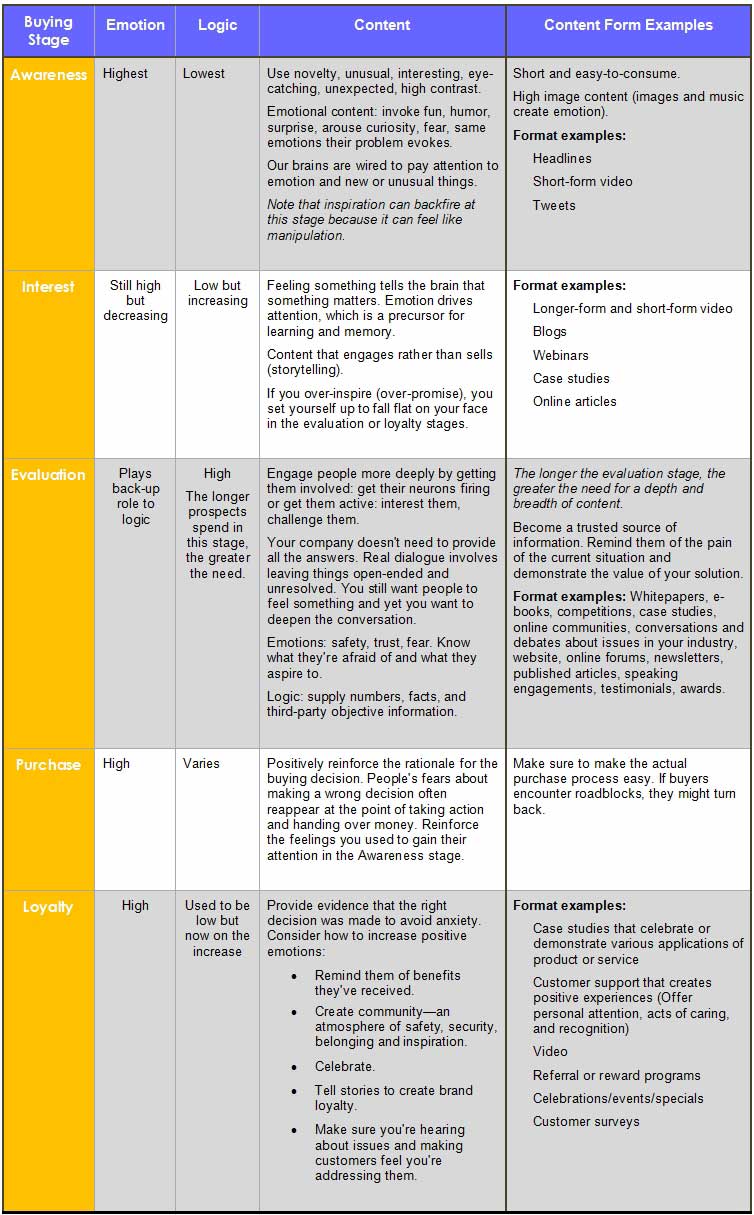Last week, in Part 1, we began to examine how emotion and logic operate in the buying cycle, and we covered what sort of content to produce for the Awareness stage. This week, the remaining four stages of the buying cycle...
Stage 2: Interest
During the Interest stage of your buying cycle, people are beginning to recognize a need for your product or service. They're aware of a problem or opportunity and the potential for a solution.
Now aware of an issue, they're are willing to spend a little more time. Thus, your content can be a little longer.
At this stage, you start building relationships with people. The need for emotional content is still high, but the need for logical content starts to build. You want content that engages rather than sells. In storytelling language, this is where you're starting to build the story of who you are—fleshing out your personality and your values.
That said, simple, inexpensive purchases won't require a lot of logic to back them up. The aforementioned Red Bull marketing is an example. By themselves, each Red Bull gives you wings video functions to get your attention. As a whole, the series of videos functions to reinforce the Interest stage.
However, chances are that if you're selling B2B, you'll need more logic in your materials. We'll discuss the reasons under the Evaluation stage.
Stage 3: Evaluation—Ramping Up the Logic
In the evaluation stage, people are seriously considering your product or service—and comparing you with your competition.
Logic becomes much more significant—particularly for complex sales. There's still an emotional component—people need to feel a sense of safety and trust—but they're looking for logical reasons on which to base those feelings.
At this stage, provide people with good, solid materials that enable people to substantiate their early feelings of security and trust; otherwise, people will feel something is off and they'll look elsewhere for solutions.
Typically, the more complex a buying decision, the more logic plays a role in the purchase decision. You might make an impulse buy in the grocery lineup with little thought, but a company making a substantial purchase tends to take longer and evaluate the effect of the purchase on their business.
In addition, the evaluation stage tends to lengthen as purchases become more complex. Overall, business-to-business purchases tend to be more complex, because...
- People doing the purchasing are experts or have more knowledge than the average buyer.
- Purchase decision-makers are accountable to more people than just themselves: There's pressure to be right and often fear of making a wrong choice.
- Frequently more than one person is involved in the buying decision (which also means your materials have to be able to satisfy a number of different buying personalities).
However, it's not just B2B markets that are becoming more complex. At one time, sellers were the experts on products; they held most, if not all, of the knowledge. With the Internet, that's no longer true. Today's consumer is a lot more savvy, which means that complex purchases are on the rise in the B2C marketplace.
How do you tell a complex purchase? Overall, complex purchase decisions...
- Are more expensive (status purchases are the exception: e.g., high-end cars, fashion, etc. These purchase decisions tend to be highly emotional)
- Tend to be more complicated: e.g., technology purchases
- Involve a higher level of buyer sophistication or knowledge
The takeaway—whether you're selling B2B or B2C—is that the longer your buyers remain in the evaluation stage, the greater logic plays a role and the greater the need for your company to provide a solid depth and breadth of content.
Stage 4: The Purchase






